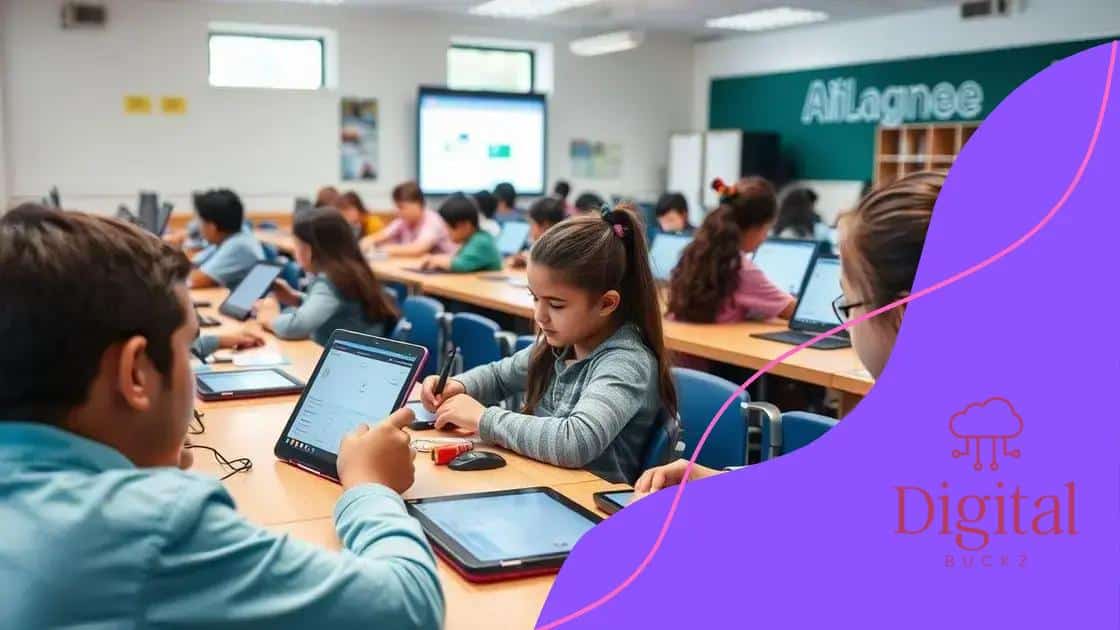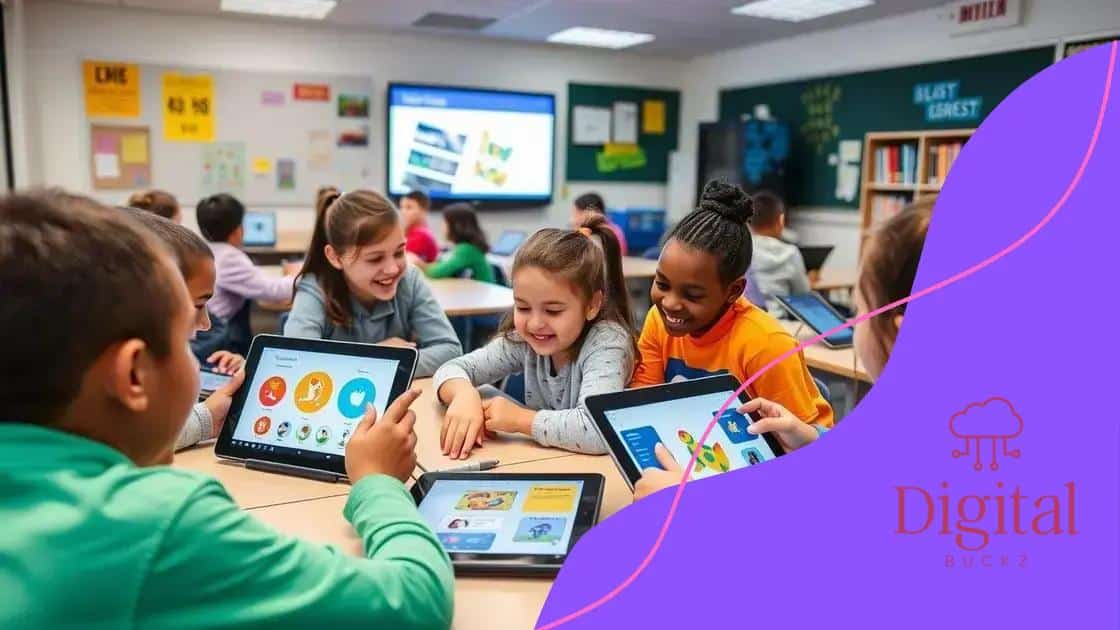Future of language learning through AI-powered platforms

The future of language learning through AI-powered platforms enhances personalized education, offering instant feedback, engaging interactive content, and diverse learning experiences that cater to individual student needs.
Future of language learning through AI-powered platforms is an exciting development that’s changing the way we learn. Have you ever imagined a language learning experience tailored just for you? Let’s dive deeper into this evolving landscape.
Benefits of AI in language learning
The use of AI in language learning brings numerous advantages that can significantly enhance the educational experience. From personalized learning pathways to instant feedback, these tools help learners achieve their goals more effectively.
Personalized Learning Experiences
One of the greatest benefits of AI is its ability to tailor language learning to individual needs. AI platforms adapt to each user’s progress, learning style, and preferences. This personalized approach keeps learners engaged and motivated.
Instant and Effective Feedback
With AI-powered tools, students receive immediate feedback on their pronunciation, grammar, and vocabulary usage. This instant correction helps reinforce learning and enhances language retention.
- Students can practice speaking with virtual tutors.
- AI evaluates spoken responses in real-time.
- Feedback is clear and constructive, guiding improvements.
This immediate assistance simulates a natural dialogue, making the process enjoyable and effective.
Enhanced Engagement through Gamification
Many AI language learning platforms incorporate gamification elements that boost engagement. Learners earn points, unlock levels, and participate in challenges that make practice fun.
- Game-like scenarios keep motivation high.
- Competition can enhance learning speed.
- Rewards encourage consistent practice.
This not only makes the experience entertaining but also increases the time spent learning.
Furthermore, AI tools often provide a vast array of interactive resources, including videos, podcasts, and quizzes, catering to various learning styles. These diverse formats ensure that learners remain engaged and can easily access materials that suit their preferences.
In conclusion, the integration of AI in language learning offers flexible, engaging, and effective ways to acquire a new language. Whether through personalized experiences or instant feedback, learners can find success at their own pace.
How AI personalizes language education
Artificial intelligence (AI) is changing the way we learn languages by offering a personalized approach. This customization helps learners achieve their goals more effectively and keeps them engaged.
Adaptive Learning Paths
Through AI, language learning platforms can create adaptive learning pathways. These pathways adjust based on each learner’s skills, preferences, and pace. This means that learners receive content that fits their exact needs, making studying more efficient.
Content Recommendations
AI also analyzes user behavior and performance to suggest relevant resources. For example, if a learner struggles with vocabulary, the AI can provide targeted exercises and quizzes to improve this area. This feature helps students focus on what they need most.
- Custom-tailored lesson plans.
- Targeted practice in weak areas.
- Dynamic content suggestions based on progress.
This intelligent background support allows learners to take ownership of their studies, making the process feel more rewarding.
Real-Time Progress Monitoring
With AI, learners receive ongoing assessments of their skills. This real-time feedback not only highlights areas for improvement but also celebrates achievements. When students see their growth over time, it boosts their confidence.
Furthermore, AI can identify the best learning methods for each individual. By understanding how a user learns best, platforms can optimize the learning experience. This individualized approach fosters a deeper connection with the language.
Incorporating voice recognition technology is another game changer. AI can evaluate pronunciation, helping students refine their speaking skills through immediate feedback.
The result is a more immersive, adaptive, and comprehensive language education experience that encourages learners to reach their full potential.
The role of interactive content in learning

Interactive content plays a vital role in language learning. By engaging learners in active participation, it helps to reinforce new concepts effectively. This approach transforms traditional education into a fun and engaging experience.
Encouraging Active Participation
When learners engage with interactive content, they are more likely to remember what they learn. This can include exercises, quizzes, and games that motivate students to practice. By incorporating interactive elements, language platforms can spark curiosity and keep learners involved.
Instant Feedback for Improvement
Interactive activities provide immediate feedback, allowing learners to understand their mistakes as they occur. This quick response helps students adjust their strategies and improve without delay.
- Users can see their scores right after a quiz.
- Immediate corrections help clarify misunderstandings.
- Real-time feedback boosts confidence.
By addressing errors promptly, learners can build a stronger foundation in the language.
Diverse Learning Styles
Interactive content caters to various learning styles, ensuring everyone can benefit. Visual learners may thrive on interactive videos, while kinesthetic learners can enjoy activities that require movement or hands-on practice. This inclusivity makes language learning accessible to a broader audience.
Furthermore, the use of interactive content encourages collaboration among peers. Group activities and discussions can facilitate language practice in a supportive environment. This peer interaction fosters communication skills and builds community among learners.
The blend of fun and educational value makes interactive content an essential tool in language education. As platforms continue to utilize these features, learners can expect a richer and more fulfilling experience.
Future trends in AI language learning
The future of AI in language learning is bright and full of potential. As technology evolves, we can expect new trends that will enhance how we acquire languages. These innovations make learning more engaging and effective.
Increased Use of Virtual Reality (VR)
One exciting trend is the rise of virtual reality in language education. VR can create immersive environments where learners practice languages in realistic settings. Imagine having a conversation in a café in Paris without leaving your home!
AI-Powered Language Tutors
Another significant trend is the development of AI-powered language tutors. These intelligent systems will provide real-time assistance and personalized feedback. Learners can interact with their tutors anytime, practicing speaking, grammar, and vocabulary at their convenience.
- Always available for practice.
- Tailored learning experiences based on individual needs.
- Encouragement through gamified challenges.
This kind of support can boost confidence and improve language skills faster.
Integration of Natural Language Processing (NLP)
As AI continues to improve, the use of natural language processing in learning platforms will become more common. NLP capabilities can analyze a learner’s speech patterns and writing skills, providing insights to help them progress.
Furthermore, AI will increasingly enable adaptive learning technologies that adjust lessons based on performance. This means that if a student struggles with a specific topic, the system can provide extra practice in that area.
Moreover, gamification will keep learners motivated. By incorporating challenges and rewards, educators will ensure that students remain engaged and eager to improve their skills. Whether through competitions or points systems, gamification will play a crucial role in the future of language learning.
Ultimately, these trends will create a more effective and enjoyable language learning experience. With advancements in technology, the possibilities for learning languages with AI are limitless.
Real-world success stories with AI platforms
Real-world success stories showcase the power of AI platforms in language learning. These examples highlight how technology can dramatically improve learners’ experiences and outcomes. From students to professionals, many individuals have benefited from using these advanced tools.
Case Study: University Students
At various universities, students are using AI language apps to prepare for their studies abroad. One student, Maria, struggled with French before using an AI platform. After just a few months of daily practice, she was able to hold conversations with native speakers confidently.
Adult Learners
Many adults, like John, have found success as well. John, a busy professional, used an AI-powered platform to learn Spanish. The flexibility of the tool allowed him to fit learning into his hectic schedule. By utilizing interactive exercises and personalized feedback, he achieved fluency in less than a year.
- Access to real-time feedback improved his speaking skills.
- Custom lesson plans matched his learning style.
- Engaging content kept him motivated.
These stories illustrate how AI platforms meet diverse learning needs and lifestyles, enhancing language acquisition.
Children and Young Learners
AI tools are also making a difference in teaching children. For example, a school in New York incorporated language learning apps in its curriculum. Kids responded positively, showing improved vocabulary and confidence in speaking.
The interactive features of the apps kept students engaged during lessons. Many reported a more enjoyable learning experience compared to traditional methods.
In addition to individual improvements, these platforms are paving the way for collaborative learning. Students work together on AI-driven assignments, fostering teamwork while practicing languages.
Such real-world examples emphasize the effectiveness of AI in language learning and its transformative impact on learners of all ages. As more people embrace this technology, the future of language education looks brighter than ever.
FAQ – Frequently Asked Questions about AI in Language Learning
How does AI personalize language learning experiences?
AI analyzes individual user data to create tailored learning paths that fit each learner’s specific needs and preferences.
What role does instant feedback play in language education?
Instant feedback helps learners correct mistakes in real-time, allowing for quick adjustments and reinforcing effective learning.
Can interactive content really enhance language learning?
Yes, interactive content engages learners actively, making the learning process more enjoyable and effective compared to traditional methods.
What are some success stories of AI being used in language learning?
Many learners, from university students to busy professionals, have successfully improved their language skills using AI-powered platforms.






